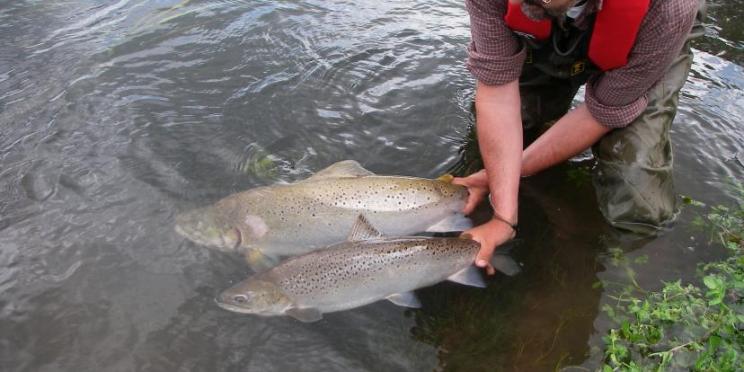SAMARCH- Project Closure Interview
17/07/2023

A question and answer session with Dylan Roberts, SAMARCH Project Manager.
Tell us about your project
The Salmonid Management Round the Channel Project (SAMARCH), is a consortia of 10 partners, five from the UK and five from France who are a blend of research, public bodies and policy focused NGO’s.
The project focused on gathering novel new evidence to better protect, conserve and inform the management of two species of conservation and economic importance in the France Channel England (FCE) coastal and transitional waters - wild Atlantic salmon and sea trout. Both species have declined significantly by some 70% over the last 40 years, partly due to climate change impacting the growth and survival of these fish in rivers and at sea, but also a number of anthropogenic impacts. The goal was to gain a better understanding of why populations of salmon are declining.
The project aimed to provide new information to:
- Reduce the by-catch of salmon and sea trout in commercial inshore fisheries
- Reduce the impact of estuarine and inshore coastal activity and developments to salmon and sea trout
- Strengthen salmon stock assessment models used by managers to manage stocks
What have been the key outputs and results for SAMARCH?
SAMARCH has gathered novel evidence on the movements, behaviour, survival and reasons for the mortality of juvenile and adult sea trout and salmon in transitional and coastal waters of the FCE.
The project team constructed a genetic database for trout and salmon from all rivers flowing into the Channel, captured adult salmon and sea trout at sea and assigned these back to their river of origin. This is to assess the movements of these fish at sea from their rivers of origin.
We’ve developed databases for all the information collected and GIS (Geographic Information Systems) based tools to visualise the projects results.
We have also interrogated thousands of fin and scale samples from juvenile and adult salmon and sea trout for long term changes over circa 30 years in their sex ratios, growth rates, fecundity, survival and marine feeding areas. This is to better understand the mechanisms behind their decline and to improve life cycle and stock assessment models to improve their management.
The project has also produced recommendations for managers for the improved management, conservation and better protection of salmon and sea trout in the FCE transitional and coastal waters. And produced some 18 scientific papers thus far, a large number of reports and raised awareness of the plight of salmon and sea trout.

Dr Celine Artero (pictured above) with a recaptured tagged sea trout at the River Tamar fish trap.
What lessons have you learned through this project?
- The difficulty in trying to protect and conserve threatened species through the myriad and often not complimentary legislation which encircle our transitional and coastal waters is hugely complex. This is a particular problem for diadromous fish like salmon and sea trout who use both the freshwater and marine waters where the legislation is very different.
- Despite spending up to 70% of their lives at sea, salmon and sea trout are all too often overlooked in marine conservation legislation. This is a particular problem in England, France has been much better in considering these threatened fish in their marine legislation.
- The need to collect better information to inform managers of the bycatch risk of protected species
What have been the highlights of delivering a cross-border project?
There have been so many. Working in collaboration with our project partners has been a wonderful experience and we have learnt so much from each other. Particularly, that salmon and sea trout both in rivers and at sea are managed and protected in very different ways on either side of the Channel. SAMARCH has enabled, NGO’s, the managers and the policy makers on both sides to understand the differences despite the challenges being similar.
What difference will this project make/ legacy will it leave?
From a management and policy perspective, the information learned from the project is now feeding into the UK’s new fisheries management plans. It has influenced and will continue to do influence the design of protection measures in the coastal waters of England and France. It has highlighted a number of knowledge gaps and management deficiencies which will be acted upon going forward to better protect these fish in transitional and coastal waters.
From a science perspective, the project has collected novel information and published a number of papers, these will be used to help guide the science around these fish going forward. There are new genetic and data basis and tools that were developed, and samples collected which can be used in future research projects.
From a people perspective, the project has worked with several hundred young people who have assisted with fieldwork, laboratory work, high level science and disseminating the results at events. They leave the project with a much greater appreciation of our rivers, transitional and coastal waters and the management of the wildlife within them.
SAMARCH ran from 2017 to 2023 with a total budget of €7.8M (of which €5.4M was funded via ERDF). It had 10 project partners including: Lead Partner Game & Wildlife Conservation Trust (UK), University of Exeter (UK,Bournemouth University (UK), Environment Agency (UK),Salmon and Trout Conservation (UK), Institut national de recherche pour l’agriculture, l’alimentation et l’environnement,I’Institut national d’enseignement superieur pour I’agriculture, I’alimentation et l’environnement (l’Institut Agro), Bretagne Grands Migrateurs, Office Francais De La Biodiversity, Seine-Normandie
Project website: Home | SAMARCH - SAlmonid MAnagement Round the CHannel
